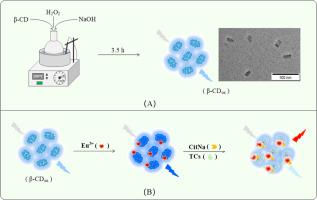Transforming β-cyclodextrin into a non-conventional luminophore via H2O2 oxidation and its application in detection of tetracyclines
IF 6.3
3区 工程技术
Q1 ENGINEERING, CHEMICAL
Journal of the Taiwan Institute of Chemical Engineers
Pub Date : 2025-10-01
DOI:10.1016/j.jtice.2025.106437
引用次数: 0
Abstract
Background
The detection of tetracyclines (TCs) has been needed due to their irreversible damage to the environment and human health.
Methods
A novel non-conventional luminophore was synthesized by oxidizing β-cyclodextrin (β-CD) with H2O2. The oxidized β-CD (β-CDox) has clustering-triggered emission (CTE) property, and exhibits blue fluorescence emission in solid powder and solution. The β-CDox and Eu3+ ions were simply mixed to fabricate a ratio fluorescence probe for detection of TC, OTC and DOX. In the presence of TCs, the red fluorescence signal of Eu3+ was significantly amplified via the inclusion interaction of β-CDox and the TCs-induced antenna effect, while the blue emission of β-CDox was reduced, allowing the ratio probe to reliably recognize TCs.
Findings
Under the optimized conditions, the ratio of I614/I430 of the developed probe displayed wide linear ranges of 1.0–30.0 µM, 1.0–30.0 µM and 1.0–40.0 µM for TC, OTC and DOX, respectively, and the limits of detection for TC, OTC and DOX were 0.25 µM, 0.23 µM and 0.48 µM, respectively. In addition, the probe was successfully applied to detect TCs in water samples. Importantly, this study has developed non-conventional luminophores-based ratio fluorescence probe, and has expanded the potential application fields of non-conventional luminophores.

H2O2氧化转化β-环糊精为非常规发光基团及其在四环素类药物检测中的应用
由于四环素类药物对环境和人类健康具有不可逆转的危害,因此需要对其进行检测。方法用H2O2氧化β-环糊精(β-CD)合成一种新型的非常规发光材料。氧化后的β-CD (β-CDox)具有簇致发光(CTE)特性,在固体粉末和溶液中均表现出蓝色荧光。将β-CDox和Eu3+离子简单混合制成比值荧光探针,用于检测TC、OTC和DOX。在TCs存在下,通过β-CDox的包合作用和TCs诱导的天线效应,Eu3+的红色荧光信号被显著放大,而β-CDox的蓝色荧光信号被减弱,使得比值探针能够可靠地识别TCs。结果在优化条件下,该探针的I614/I430比值对TC、OTC和DOX的检测范围分别为1.0 ~ 30.0µM、1.0 ~ 30.0µM和1.0 ~ 40.0µM,对TC、OTC和DOX的检出限分别为0.25µM、0.23µM和0.48µM。此外,该探针已成功应用于水样中tc的检测。重要的是,本研究开发了基于非常规发光基团的比例荧光探针,拓展了非常规发光基团的潜在应用领域。
本文章由计算机程序翻译,如有差异,请以英文原文为准。
求助全文
约1分钟内获得全文
求助全文
来源期刊
CiteScore
9.10
自引率
14.00%
发文量
362
审稿时长
35 days
期刊介绍:
Journal of the Taiwan Institute of Chemical Engineers (formerly known as Journal of the Chinese Institute of Chemical Engineers) publishes original works, from fundamental principles to practical applications, in the broad field of chemical engineering with special focus on three aspects: Chemical and Biomolecular Science and Technology, Energy and Environmental Science and Technology, and Materials Science and Technology. Authors should choose for their manuscript an appropriate aspect section and a few related classifications when submitting to the journal online.

 求助内容:
求助内容: 应助结果提醒方式:
应助结果提醒方式:


